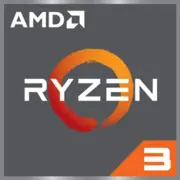AMD Ryzen 3 PRO 4450U

AMD Ryzen 3 PRO 4450U: A Balance of Mobility and Performance in 2025
Overview of the Processor for Ultrabooks and Work Tasks
Architecture and Technology Process: 7 nm Zen 2 and Integrated Graphics
The AMD Ryzen 3 PRO 4450U processor, introduced in 2020, remains relevant in the budget segment due to its successful Zen 2 architecture and 7-nanometer TSMC FinFET technology.
Key Specifications:
- 4 cores and 8 threads thanks to Simultaneous Multithreading (SMT) technology.
- Base clock speed: 2.5 GHz, maximum in turbo mode: up to 3.7 GHz.
- Cache: 4 MB L3, 2 MB L2.
- Integrated graphics: AMD Radeon Graphics with 5 compute units (CUs) and a frequency of up to 1400 MHz.
Although Zen 2 lags behind modern Zen 4 in IPC (instructions per clock), the 7-nm technology ensures low energy consumption and good thermal efficiency. The integrated Vega 5 graphics handle basic tasks: rendering interfaces, 4K video, and light gaming.
Power Consumption and TDP: 15 W for Thin Devices
With a TDP of 15 W, the Ryzen 3 PRO 4450U is ideal for ultrabooks and budget laptops. In idle mode, the processor reduces its clock speed to 1.4 GHz, consuming less than 5 W. Under full load (e.g. video rendering), power consumption reaches 25 W, but the cooling system can handle brief spikes.
Power-saving Technologies:
- Precision Boost 2 — automatic core overclocking based on load and temperature.
- Cool’n’Quiet — disables unused components.
- Adaptive Power Management — intelligent workload distribution among cores.
Performance: Office, Multimedia, and Light Gaming
Geekbench 6:
- Single-core test: 1209 points.
- Multi-core test: 3628 points.
Real-world Scenarios:
1. Office Work:
- Concurrently working with 20+ tabs in Chrome, Word/Excel documents, and Zoom — without lag.
- System load: 10-15% in idle mode, 70-80% under active use.
2. Multimedia:
- Streaming 4K video on YouTube: GPU load — 40-50%, CPU — 20%.
- Photo editing in Lightroom: exporting 100 images takes about 3 minutes.
3. Gaming:
- CS:GO — 45-55 FPS on medium settings (720p).
- GTA V — 30-35 FPS on low settings (720p).
- Fortnite — 25-30 FPS (720p, Performance mode).
Turbo Mode:
Under load, the processor maintains a frequency of 3.5-3.7 GHz for up to 2-3 minutes before it drops to 2.8-3.0 GHz due to heat. In compact laptops (e.g. Lenovo ThinkPad E14), this can lead to throttling — it's important to choose models with a quality cooling system.
Use Cases: Who is the Ryzen 3 PRO 4450U Suitable For?
1. Students and Office Workers:
- Document work, online learning, video conferencing.
2. Budget-conscious Users:
- Laptops based on this processor start from $500 (new models of 2025, such as the HP ProBook 445 G8).
3. Business Segment:
- Support for AMD PRO security technologies (data encryption, attack protection).
Not Suitable For:
- Professional 4K video editing.
- Modern AAA gaming.
Battery Life: Up to 10 Hours of Operation
In laptops with a 50-60 Wh battery (e.g., Acer Swift 3), the operating time is:
- Web surfing: 8-10 hours.
- Video playback: 12 hours.
- Maximum load: 2.5-3 hours.
Tip: To extend battery life, disable turbo mode in power settings and use dark themes.
Comparison with Competitors
1. Intel Core i3-1215U (12th generation, 10 nm):
- Better in single-threaded tasks (+15%), but weaker in multi-threading (-20%).
- Integrated Intel UHD graphics — 30% slower than Radeon.
2. Apple M1 (5 nm):
- Advantage in energy efficiency (up to 18 hours of battery life).
- Higher performance in video editing, but limited compatibility with Windows software.
3. AMD Ryzen 5 5500U:
- 6 cores/12 threads, 40% faster in multitasking, but TDP of 25 W.
Pros and Cons
Strengths:
- Low price of laptops ($500-700).
- Support for multithreading for parallel tasks.
- Good energy efficiency.
Weaknesses:
- No support for PCIe 4.0.
- Limited performance in heavy applications.
Recommendations for Choosing a Laptop
1. Type of Device:
- Ultrabooks (e.g., ASUS Vivobook 14).
- Business laptops (Dell Latitude 3445).
2. What to Pay Attention To:
- RAM: Minimum 8 GB (16 GB is better for multitasking).
- Storage: 512 GB SSD (NVMe speeds up system boot).
- Screen: Full HD (IPS matrix for comfortable work).
- Ports: USB-C with charging support.
Final Conclusion
The AMD Ryzen 3 PRO 4450U is an optimal choice for those seeking an affordable laptop for study, office work, and travel. Its strengths include a balance of battery life (8-10 hours) and sufficient performance for everyday tasks. However, for gaming or professional workloads, consider more powerful models like the Ryzen 5 6600U or Intel Core i5-1235U.
Key Benefits in 2025:
- Affordable pricing amidst inflation.
- Reliability and longevity.
- Compatibility with modern software and peripherals.
If your budget is limited and your tasks are basic, the Ryzen 3 PRO 4450U remains one of the best options on the market.
Basic
CPU Specifications
Memory Specifications
GPU Specifications
Miscellaneous
Benchmarks
Compared to Other CPU
Share in social media
Or Link To Us
<a href="https://cputronic.com/en/cpu/amd-ryzen-3-pro-4450u" target="_blank">AMD Ryzen 3 PRO 4450U</a>